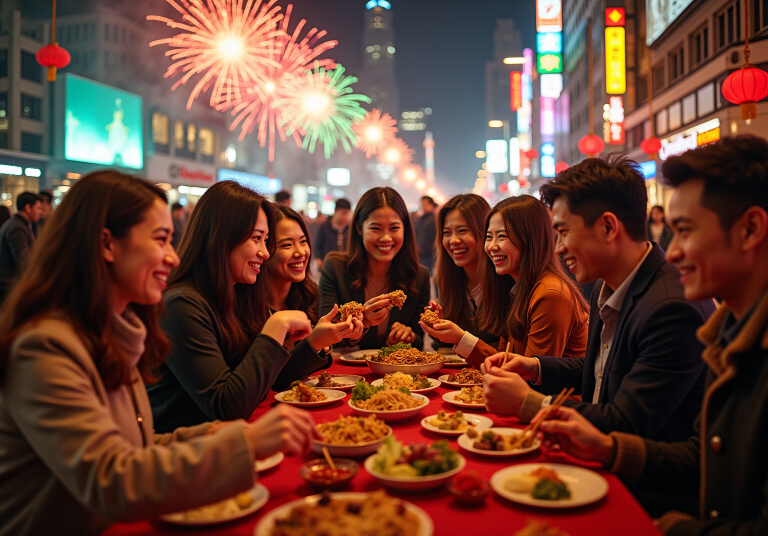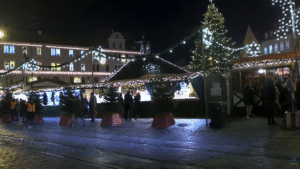Overview
New Year celebrations around the world are such a vibrant tapestry of traditions! Each culture brings its own unique customs, like Spain’s grape-eating ritual or Thailand’s lively Songkran water festival. Isn’t it fascinating how these festivities not only reflect rich cultural heritage but also evolve with modern practices? They highlight our shared human desire for connection and hope as we step into a new year. It’s a beautiful reminder of how we all come together, no matter where we are!
Key Highlights:
- New Year celebrations vary globally, with January 1st marked by fireworks and resolutions in many Western countries.
- The Lunar New Year, celebrated in places like China, emphasizes family gatherings and traditional customs like giving red envelopes.
- Vietnam’s Tết festival showcases family togetherness and cultural heritage, reinforcing the importance of storytelling.
- Thailand’s Songkran water festival symbolizes purification and renewal, highlighting diverse cultural practices.
- Spain’s tradition of eating 12 grapes at midnight is believed to bring good fortune for the year ahead.
- In Brazil, celebrants wear white and jump over seven waves to symbolize wishes for the new year.
- Japan’s New Year meal includes soba noodles, representing longevity and family unity.
- Philippines’ tradition involves eating 12 different fruits for good luck and wealth.
- Common themes in New Year celebrations include family, community, renewal, and culinary traditions that symbolize prosperity.
- Modern adaptations of New Year festivities include large public events, virtual gatherings, and a focus on sustainability and inclusivity.
Introduction
As the clock strikes midnight around the globe, a vibrant symphony of diverse traditions and cultural expressions bursts forth in celebration of the New Year! From the dazzling fireworks lighting up the skies of Western cities to the serene family reunions during the Lunar New Year in Asia, these festivities weave together a rich tapestry of human experience. Each culture adds its unique flavor to the occasion—think of the vibrant water fights of Thailand’s Songkran or the symbolic 12 grapes consumed in Spain for good luck!
As we dive into the intricate customs and shared themes defining New Year celebrations worldwide, we uncover deeper insights into the values of community, renewal, and hope. These celebrations reflect our collective aspirations as we welcome new beginnings together. So, are you ready to explore the exciting ways people around the world ring in the New Year?
Global Overview of New Year Celebrations
Festivities celebrating New Year around the world showcase a lively mix of cultural identities and customs! In many Western countries, January 1st marks the start of this new cycle, filled with fireworks, vibrant celebrations, and the setting of resolutions. On the flip side, the Lunar New Festival, celebrated in places like China, shifts each year and is all about family gatherings, dragon performances, and the giving of red envelopes to bring good luck.
In Vietnam, Tết aligns with the Lunar New Festival and is a significant occasion that emphasizes family togetherness and cultural heritage. This festival not only strengthens family bonds but also highlights the rich traditions of Vietnamese culture, showcasing the importance of storytelling in understanding various customs.
Then there’s Thailand’s Songkran, celebrated in April, which marks the traditional Thai New Era. Known for its water festival, this celebration symbolizes purification and renewal. It beautifully illustrates the diverse customs associated with celebrating New Year around the world, and the cultural significance of these observances is profound globally. For instance, Kwanzaa, a relatively new holiday, celebrates Black American culture and culminates in a feast known as Karamu, reflecting the values of community and heritage. This connection to cultural significance underscores the importance of understanding the stories behind these events. Plus, it’s fascinating to note that four nations—Ethiopia, Nepal, Iran, and Afghanistan—do not follow the Gregorian calendar, marking their New Beginning at various times, further showcasing the rich tapestry of global customs.
As we approach 2025, the landscape of New Beginning observances continues to evolve, with each tradition offering a unique perspective on cultural values and community connections. These celebrations, centered around celebrating new year around the world, are not just moments of festivity; they weave a rich tapestry of shared human experiences, inviting you to appreciate the myriad ways people welcome new beginnings!
Cultural Traditions: Unique Practices Across Continents
Celebrating New Year around the world showcases a colorful tapestry of cultural practices just waiting to be discovered! In Spain, for instance, there’s a delightful custom of eating 12 grapes at midnight—one for each clock chime. This fun tradition is believed to bring good fortune and wealth for the year ahead. Imagine the excitement as you try to eat them all in time!
Then, let’s hop over to Brazil, where celebrants wear white clothing and leap over seven waves at the beach. Each jump symbolizes a wish for the upcoming year, and it’s such a vibrant celebration rooted in Afro-Brazilian culture. The ocean is seen as a source of renewal and blessings, making it a truly special experience.
Meanwhile, in Japan, families gather to enjoy a meal featuring soba noodles, which symbolize longevity and resilience. This custom beautifully reflects the Japanese value of family unity and the hope for a long, healthy life together.
And don’t forget about the Philippines! On New Year’s Eve, it’s traditional to eat 12 different varieties of fruit, each representing a month of the year. This is all about good luck and wealth, making the celebration even more meaningful.
In Vietnam, Tet, or the Lunar New Year, is a time for family gatherings and honoring ancestors. It really highlights the importance of cultural heritage during this festive period, particularly when celebrating New Year around the world, where each of these traditions is not just a festive ritual; they encapsulate deeper cultural meanings, embodying aspirations for prosperity, health, and happiness in the year ahead. So, which tradition resonates with you? Let’s explore these wonderful customs together!
Common Themes and Values in New Year Celebrations
The celebrations for celebrating New Year around the world are wonderfully diverse, yet they reveal some common threads that unite us all. At the heart of these festivities is a strong focus on family and community. Many cultures prioritize gathering with loved ones to mark special occasions. Did you know that 54% of parents with children set New Year’s resolutions? This highlights how important collective goals and ambitions are within families!
The idea of renewal and fresh starts resonates widely. It often shows up in practices like house cleaning to sweep away bad luck or establishing personal resolutions aimed at self-improvement. An interesting twist? June 1 has become known as ‘New Year’s Resolution Recommitment Day.’ It’s a perfect time for you to reassess and renew those commitments! And here’s a fun fact: 86% of individuals who made a resolution last year did so again, compared to just 11% of those who didn’t. This really emphasizes how resolutions play a significant role in our lives. Plus, 55% of people plan to pick up a new hobby during the year, showcasing that theme of personal development, particularly when celebrating New Year around the world, where food is another essential element of these celebrations. Many cultures whip up unique dishes believed to bring good luck. This culinary aspect not only enhances the festive atmosphere but also reinforces the values of sharing and abundance, particularly while celebrating New Year around the world. These universal themes highlight a shared human desire for hope, connection, and prosperity as we embark on a new cycle. They beautifully demonstrate how family and community values are woven into the very fabric of celebrating New Year around the world.
Modern Adaptations: Evolving New Year Celebrations
In recent times, the festivities celebrating New Year around the world have gone through some exciting changes, all thanks to globalization and technological progress! Major cities now host large-scale public events, like the iconic ball drop in Times Square, New York. This spectacular event is broadcast globally, allowing millions of you to join in virtually! How amazing is that?
The rise of social media has truly revolutionized these celebrations. Virtual gatherings and online countdowns have become the norm, making it easier for people to connect, no matter the distance. Isn’t it wonderful how technology brings us all together?
Moreover, traditional practices are being reimagined to align with modern values. We’re seeing environmentally friendly festivities and a beautiful blend of various cultural elements. Cities like Virginia Beach, Honolulu, and Plano have been recognized for their creative ways of celebrating New Year around the world, blending local traditions with contemporary styles. These adaptations reflect a dynamic interplay between tradition and modernity, showing how New Year observances continue to evolve while keeping their essential significance intact.
As we approach 2025, the trends indicate a growing emphasis on inclusivity and sustainability. This ensures that the spirit of celebration resonates with a broader audience, making it an even more special time for everyone!
Conclusion
Exploring New Year celebrations around the globe reveals a vibrant mosaic of traditions, each reflecting unique cultural identities and values. From the dazzling fireworks of Western nations to the cozy family gatherings of the Lunar New Year in Asia, these customs highlight the significance of renewal and community. Just think about Spain’s tradition of eating 12 grapes at midnight or Thailand’s lively Songkran festival—these celebrations show how different cultures embody hopes for prosperity and purification, showcasing the rich diversity in the ways people welcome new beginnings.
Common themes emerge from these festivities, emphasizing the importance of family and shared aspirations. Gathering with loved ones and setting resolutions is a universal desire for connection and personal growth. Food plays a central role in these celebrations, symbolizing abundance and the joy of sharing, which further strengthens the bonds within communities.
As New Year celebrations continue to evolve with globalization and technology, they remain deeply rooted in tradition while embracing modern adaptations. Public events and virtual gatherings exemplify this dynamic interplay, ensuring that the essence of these celebrations resonates with a broader audience. Ultimately, the rich tapestry of New Year customs not only reflects individual cultural narratives but also reinforces a collective hope for renewal, connection, and prosperity in the year ahead. So, as you reflect on your own traditions, what hopes do you carry into the new year?
Frequently Asked Questions
What is celebrated on January 1st in many Western countries?
January 1st marks the start of the new year in many Western countries, characterized by fireworks, vibrant celebrations, and the setting of resolutions.
How is the Lunar New Year celebrated in countries like China?
The Lunar New Year, celebrated in places like China, involves family gatherings, dragon performances, and the giving of red envelopes to bring good luck. The date of this festival shifts each year.
What significance does Tết hold in Vietnam?
Tết aligns with the Lunar New Year and emphasizes family togetherness and cultural heritage. It strengthens family bonds and showcases the rich traditions of Vietnamese culture, particularly the importance of storytelling.
What is Songkran and how is it celebrated in Thailand?
Songkran is celebrated in April in Thailand and marks the traditional Thai New Era. It is known as a water festival, symbolizing purification and renewal.
What is Kwanzaa and what does it celebrate?
Kwanzaa is a relatively new holiday that celebrates Black American culture and culminates in a feast known as Karamu, reflecting the values of community and heritage.
Which countries do not follow the Gregorian calendar for their New Year celebrations?
Ethiopia, Nepal, Iran, and Afghanistan do not follow the Gregorian calendar and mark their New Beginning at various times throughout the year.
How do New Year celebrations reflect cultural values and community connections?
New Year celebrations around the world weave a rich tapestry of shared human experiences, inviting appreciation for the diverse ways people welcome new beginnings and the cultural significance behind these observances.


































